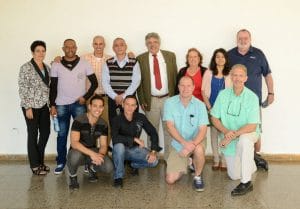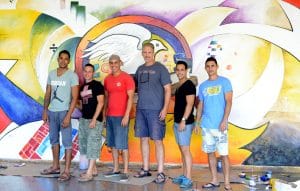
SAU art professor Steven Ochs, center, poses with members of his team in front of the finished mural at the University of Artemisa.
Two Southern Arkansas University professors visiting Cuba over the Thanksgiving break found themselves in the country during a historic event: the death of Fidel Castro.
Dr. Edward Kardas, distinguished professor of psychology and director of the SAU Honors College, and Steven Ochs, professor of art, were in Cuba Nov. 20-26 working on an art project at the University of Artemisa. They, along with SAU sophomore Veronica Ramirez, were participating in a long-planned trip to the Cuban university. None expected their visit to coincide with the passing of Cuba’s former president. Castro’s death reminded Kardas of his own early years in Havana.
“I lived in Cuba from 1957 to 1960,” Kardas said. “My father was a State Department Foreign Service officer. Havana was his post then. The first time I heard Castro’s name was on Jan. 1, 1959, when I was nearly 10 years old. On Saturday, again in Cuba, I heard he had died. A lot of history has fallen in between those two personal bookends.”
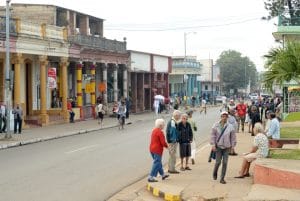
The trip was Kardas’ fourth to Cuba since relations were normalized between the socialist country and the United States. SAU has been attempting to establish an exchange program with one or more Cuban universities, and Kardas joined three previous delegations. It was Ochs’ first visit to Cuba and an eye-opener for him.
“I thought the people were warm, conscientious, and educated,” Ochs said. “They take the time to greet each other every day – a kiss on the cheek for the women, a handshake for the men. It’s sincere. The people share a single soul.”
In Cuba, Kardas met frequently with university and government officials while Ochs worked with art professors and students on a mural symbolizing the relationship between Artemisa and SAU. Language was not the only barrier they encountered; there was also governmental bureaucracy. “Art materials shipped from the U.S. never left the customs house in Havana. They were delivered on time,” Ochs said of products donated by Smith Paint, “but we didn’t have signatures we needed, so they were never released.”
Ochs and his team needed “a Plan B. We’re in the creativity business. We solve problems.”
“We were working so closely together that at times I forgot I don’t speak Spanish and they don’t speak English,” Ochs said. “We were speaking art. Art obliterates barriers. That’s a cool feeling.”
Kardas helped track down substitute materials, obtainable only by making an 80-mile round trip from Artemisa to Havana. This exposed the group to one of the true dangers of daily life in Cuba: traffic.
“You drive down the middle of the road, there are no shoulders, and the sides of the road are full of pedestrians, motorcycles, scooters, horse-drawn buggies, and not one has a reflector,” Ochs said. “After a couple of hours, we had to pull over and wipe off the oily exhaust from the windshield. You can imagine the combination of darkness, oncoming headlights, and shadows of human obstacles everywhere.”
Work on the mural continued. “We wanted to have a successful project, against all odds,” Ochs said. “We wanted to make a statement, and Cubans are very passionate people, they don’t give up.”
He found that communicating with art-minded people wasn’t difficult despite the language barrier.
“We were working so closely together that at times I forgot I don’t speak Spanish and they don’t speak English,” Ochs said. “We were speaking art. Art obliterates barriers. That’s a cool feeling.”
Kardas, meanwhile, found himself reverting to the language he had not spoken since he was 14. “I grew up bilingual in English and Spanish. I don’t think about what I’m going to say (in Spanish), it just comes out. Every time I go to Cuba, my Spanish gets better, but I don’t think anyone in the world can do something like this without a competent translator.”
Ramirez helped with translation and documented work on the project. She and Ochs also took photos of life on the street, which was colorful, loud and vibrant.
Ochs said he and his team worked to ensure that the mural was an artwork that related to the people who would see it every day.
“We did nothing for decoration, everything was to communicate or express meaning,” he said. “That’s the same thing we try to get our students to do.”
He said the project illuminated the talents of the Cuban art students. “They had a strong foundation in the language of elements and principles of design.”
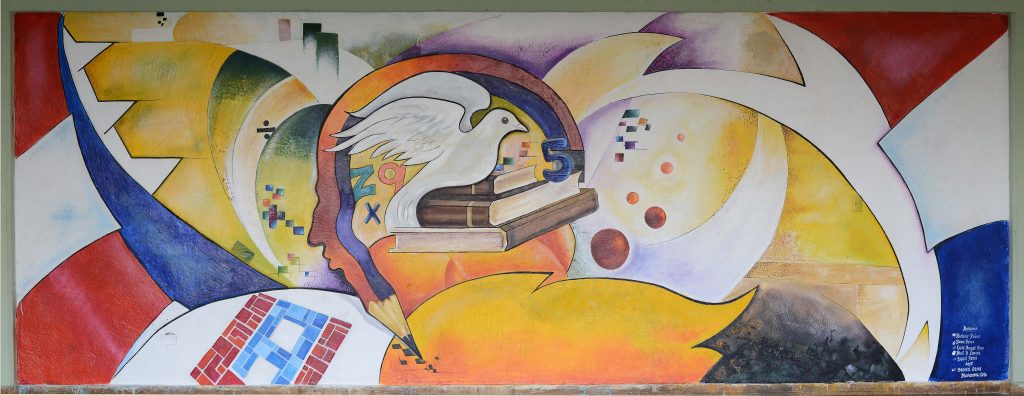
Steven Ochs, art professor at Southern Arkansas University, and a team of Cuban art professors and students completed this mural at the University of Artesmia.
Ochs gave instruction in safe handling of tools. “This was the first time the students or professors had used these tools. It took a little while for them to gain confidence. Professor Pedro Llano was surprised I was letting people help. They thought I would be creating (the mural) myself and they would watch. I told him it was more important that we all have ownership of the mural. Since we were leaving the tools as a gift from Bosch, it was also important that they learn to use them properly, so they may create murals in the future.”
The Cubans and Americans “worked so well together,” he said. The students “were focused, excited, energetic and showed a real love for the project through their actions. Several times, we would stop to negotiate color, techniques, etc., and always arrive at a consensus.”
Both professors commented on the food. Breakfast consisted of a ham and cheese bun and coffee. They were frequently served orange soda, which Ochs said was “the equivalent of sweet tea in the South.” For dessert: a piece of cheese in guava sauce.
They also saw lots of construction. “If one wasn’t paying attention, you could step off the edge and fall eight feet to the ground. In America, everything we do in construction, manufacturing, etc., is to avoid being sued. Here, pay attention or it’s your own fault,” Ochs said.
On their last day in Cuba, they heard of the death of Castro. “As Americans, we were a little uneasy not knowing how everyone was feeling or how they would react,” Ochs said. “An interesting thing happened that morning while I was photographing around our hotel. A man in his sixties approached me and asked if I had a permit to take photos. I told him no and signaled to Veronica to help out with the translations. According to him, I couldn’t take photos without a permit.”
I was thinking, ‘Are we stuck here, are we going to be able to get out?’
Ochs was reminded that he had been out every day “taking photos of people, cars, dogs, architecture, without a problem from anyone.” The old man, he said, was remembering “the way things used to be, not thinking of how they are today.”
“I had anticipated that Castro might die while we were in Cuba,” Kardas said, “but it took me by surprise. I was thinking, ‘Are we stuck here, are we going to be able to get out?’ But the airport was normal.”
Kardas said Castro “had exiled a generation while taking their property and killing many of their family and friends. I could understand the joyous demonstrations in South Florida after his death was announced.”
He said it is a “shame that Cuba is so close (to the U.S.) yet so distant in many other ways. Cuba is a unique place. It’s at once cosmopolitan, hip, rural, vital and safe. It’s also socialist and run with an incredible amount of red tape.”
Plans for delegates from Artemisa to visit SAU next year “are being carefully prepared,” Kardas said. “We want it to be an all-inclusive plan.”
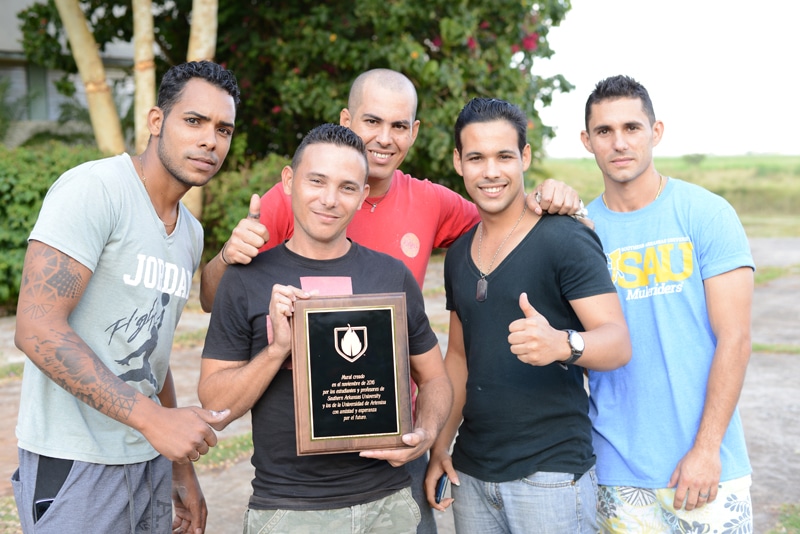
Art students at the University of Artemisa pose with a commemorative plaque given by Southern Arkansas University.
He said Dr. Trey Berry, SAU president, is supportive of an exchange program with Artemisa, as are school officials there. Any program, however, must be designed to satisfy the Cuban government. “The trick is to get it approved,” Kardas said.
Before departing Artemisa, “victory photos” were taken with all the professors and students who worked on the mural. “Our Cuban friends gave each of us a gift bag,” Ochs said, “and we received caricatures that were hilariously accurate and very well executed. We were also presented with an official document of appreciation from the University.” The SAU delegation also gave a plaque; each of the participating Cubans was photographed holding the plaque.
“We hope to bring our Cuban friends to Magnolia next summer to work on a big project on our campus,” Kardas said.

